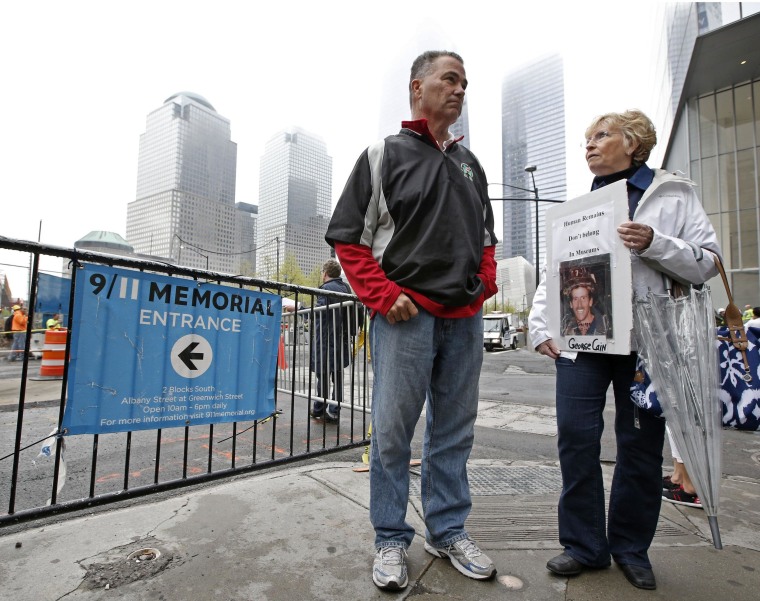The long-delayed National September 11 Memorial Museum's grand opening marks the culmination of an emotionally charged and politically fraught journey that remains clouded by another chronic concern: money.
The museum, which descends into the bedrock below ground zero, and a street-level memorial plaza featuring a pair of waterfalls that opened to the public in 2011, together cost more than $700 million to build, a massive sum that was covered by government agencies and private donations, including $15 million from former Mayor Michael Bloomberg.
But that tab did not include the annual estimated $63 million it will cost to operate the site. That is primarily why a ticket to the museum, which opens to the public May 21, will cost $24, with exceptions for victims’ families and those who worked in the rescue and cleanup operations. The memorial plaza is free.
Some have criticized the ticket price as prohibitively expensive, the reflection of bloated salaries and grandiose visions.
“This is becoming a revenue-generating tourist attraction,” said Jim Riches, a retired New York Fire Department chief whose firefighter son was killed in the World Trade Center. He donated his son’s helmet to the museum, but refused to attend this week’s pre-opening ceremonies. “They went way overboard,” he said.

But supporters argue that the price isn’t out of line of other major New York museums and tourist attractions.
Retired firefighter Lee Ielpi, who also lost a firefighter son in the attacks and now serves on the museum’s board of directors, acknowledged that the price tag was “monumental,” but so was the mission.
“This is a major institution that speaks of the events of 9/11,” Ielpi said. “The price tag has to be there. You can’t expect these things to be free.”
At this point, the museum doesn’t have many other options.
Its board of trustees tried to get the federal government to pitch in, but Congress is not in a generous mood: a 2011 bill that would have contributed $20 million a year was blocked, and it appears highly unlikely that a similar measure would fare any better.
"Until we get that money, we have to get the money from someplace."
“That’s not at all a reflection of the value or the significance of the 9/11 museum; they just don’t want to spend the money,” said Lee White, executive director of the National Coalition of History, a Washington D.C. advocacy group.
Just last week, White pointed out, the House of Representatives couldn’t pass a bill to study the possibility of a women’s history museum until language was inserted assuring that no federal money be spent on it.
“If Congress is reticent to pay for a commission to study the need of a National Women’s History Museum, you can imagine how reticent they are to fund any museum,” he said.
Joe Daniels, the 9/11 museum's president, and a spokesman did not respond to requests for comment.
President Barack Obama did not address the funding issue in remarks at the museum on Thursday. A White House spokesman was asked about it earlier in the week, but provided no answers.
In a news conference that preceded a media tour of the museum, Bloomberg, who serves as the museum's chairman, said he agreed with those who argue that admission should be free. "And if you believe as I do, I would suggest you call your congressman or senator," he said.
The 9/11 museum is simply trying to get the same kind of federal funding that other "national museums" receive, Bloomberg said. "Until we get that money, we have to get the money from someplace."
According to the American Alliance of Museums, federal support of museums is steadily shrinking. Two decades ago, the typical museum got 37 percent of its funding from government sources. In 2010, the number had fallen to 24 percent. “We suspect it’s smaller today,” spokesman Dewey Blanton said.
By comparison, the Oklahoma City Memorial and Museum receives no government funding, and charges $12 admission. The U.S. Holocaust Memorial Museum in Washington receives $52.4 million in government funds, and is free.
In the absence of federal support, the 9/11 museum expects to cover two-thirds of its operating expenses with ticket and concession sales, and the rest through fundraising. But it has not given up on government sources. New York’s U.S. Senate delegation is working on a long-shot proposal to transfer the memorial plaza to the National Park Service. The museum has appealed to Mayor Bill de Blasio, who has been noncommittal. It may also tap a $15 million low-interest loan offered by Bloomberg last year.
But the museum’s strongest advocate may end up being the place itself.
Early reviews are overwhelmingly positive, and if the public reacts similarly, the museum perhaps won’t be seen by budget hawks as unworthy of assistance.
“Here we are, one more step forward,” Ielpi said. “Now we’ll see how well it is received.”
With reporting by Andrew Rafferty